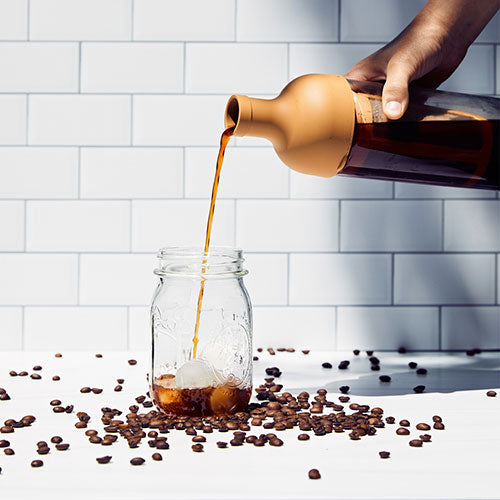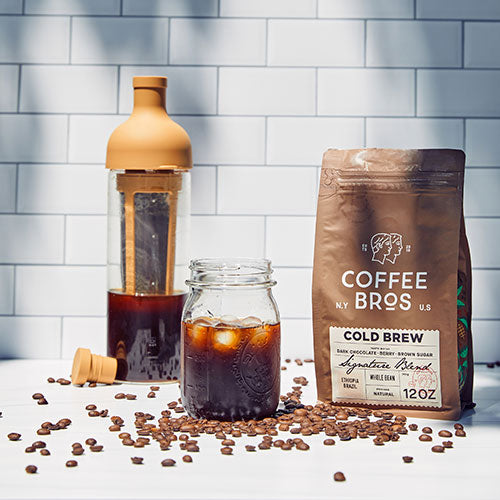Espresso Drink Calculator
| Drink Type | Espresso |
| Shot Type | Single Espresso |
| Coffee needed | 9g |
| Brew Strength | Normal (1:2) |
| Extraction Yield | 18g |
| Steam milk needed | 0g or 0 ounces |
| Total Beverage Size | 18g or 0 ounces |
How to use the Coffee Brew Calculator?
We’ve created a simple 8-step tool to calculate the milk-to-espresso ratio for five popular drinks latte, cappuccino, flat white, cortado, and macchiato. You can also use the tool for single-shot espresso, double shot espresso, and at varying strength levels, all while keeping the milk-to-espresso ratio intact.
Step 1: Choose your espresso drink type. The calculator will only add milk to your drink if you choose a milk-based espresso drink like macchiato, cortado, latte, flat white, or cappuccino.
Step 2: Choose your shot type, either Single or Double. We know basket sizes can vary, and the ideal grams in your portafilter should be +2 or -2 based on its specs. For example, the popular VST-18-gram basket can handle between 16 and 20 grams of coffee grounds. We typically pull our double espresso shots with a VST-20 basket using 20g of espresso.
In this step, you will choose a single or double shot and the number of grams of coffee you would like to brew with.
Step 3: Note the number of grams you should grind into your portafilter and use any shot preparation, like using a WDT or adding a puck screen.
Step 4: Choose your brew strength. If you chose a double shot and 20 grams of coffee, the standard ratio of 1:2 would be 1g of coffee to 2g of liquid resulting in a 40-gram shot. If you would like a more robust 20-gram shot, consider going down to a 1:1.5 ratio which means you’ll end up with 30 grams of liquid instead of the standard 40 grams.
Step 5: Note your extraction yield (espresso liquid) in either grams or ounces.
Step 6: Depending on the drink chosen and shot type and strength, step 6 will detail the amount of steamed milk you need to finish your drink. We kept the milk-to-espresso ratios balanced, where the required milk will fluctuate based on your espresso extraction yield. The ratios chosen are on the classic side of things; no watered-down milk-based drinks here!
Step 7: Note your total beverage size of extraction yield (espresso liquid) and steamed milk needed.
Step 8: Note your final recipe, share it with friends, or adjust it as needed!
Milk to Espresso Ratios
Milk to espresso ratio for a latte
We recommend using a 20g double shot of espresso at a 1:2 ratio resulting in 40g (1.4 ounces) of espresso extraction. We will top off our espresso with 230 – 240g (8.1 ounces) of milk resulting in a 9.5 – 9.9 ounce latte!
You can use our milk-to-espresso drink calculator to adjust these ratios for a more or less rich latte.
Milk to espresso ratio for a cappuccino
We recommend using a 20g double shot of espresso at a 1:2 ratio resulting in 40g (1.4 ounces) of espresso extraction. We will top off our espresso with 100g (3.5 ounces) of milk resulting in a perfect 5-ounce cappuccino!
You can use our milk-to-espresso drink calculator to adjust these ratios for a more or less rich latte.
Milk to espresso ratio for a cortado
We recommend using a 20g double shot of espresso at a 1:2 ratio resulting in 40g (1.4 ounces) of espresso extraction. We will top off our espresso with 55g (2.0
ounces) of milk resulting in a perfect 3.4-ounce cortado!
You can use our milk-to-espresso drink calculator to adjust these ratios for a more or less rich latte.
Milk to espresso ratio for a macchiato
We recommend using a 20g double shot of espresso at a 1:2 ratio resulting in 40g (1.4 ounces) of espresso extraction. We will top off our espresso with 25g (0.88 ounces) of milk resulting in a perfect 2.3-ounce macchiato!
You can use our milk-to-espresso drink calculator to adjust these ratios for a more or less rich latte.
Espresso 101
How to make a single shot of espresso?
Using a single basket, finely grind 7 - 9 grams of coffee, distribute the grounds evenly, tamp with 30lbs of pressure, then extract 14 - 18 grams of espresso at a 1:2 ratio within 25 – 30 seconds at 201°F.
What are espresso brew ratios?
Espresso brew ratios are the amount of coffee grounds used versus the final extraction yield or liquid in your cup.
For example, a double espresso calls for a 1:2 ratio, meaning that for every 1 gram of ground coffee in your espresso portafilter, you aim for 2 grams of espresso yield in your cup. A standard double espresso recipe would call for 19 grams of finely ground coffee in your portafilter, yielding 38 grams of espresso in your cup and typically within 30 – 35 seconds.
What is the difference between a ristretto and a single shot of espresso?
Espresso drinks all start at a recommended brew ratio (though there is some flexibility in the numbers) which states the amount of ground coffee to the extracted espresso yield.
Traditionally, a ristretto espresso is a 1:1 ratio of coffee grounds to extracted espresso. An example of a ristretto would be using a single basket with 9 grams of coffee, yielding 9 grams of espresso. The closer the ratio is to 1:1, the more intense and heavier mouthfeel the espresso shot will be. The further the ratio is from 1:1, let’s say a 1:3 ratio ( gram of coffee grounds to 3 grams of water), the higher clarity and less intense of a shot it becomes.
There are two ways to craft a single shot of espresso, but both will be at a 1:2 ratio (1 gram of coffee to 2 grams of water). The first is using a single basket, finely grinding 7 - 9 grams of coffee to yield 14 – 18 grams of espresso. The second method would be a double basket, finely grinding 19 grams of coffee and splitting the yield between two espresso cups. This second method yields two single shots of espresso and is for those who prefer the extraction from a double basket better than a single basket or those in a commercial setting.
What is the difference between a double shot and a lungo?
All espresso drinks start with a ratio of ground coffee to brewed espresso. A double shot of espresso uses a 1:2 ratio meaning that for every 1 gram of ground coffee in your portafilter, you aim for 2 grams of espresso yield in your cup. A typical double shot of espresso recipe would call 19 grams of finely ground coffee in your portafilter, yielding 38 grams of espresso within 25 – 30 seconds.
A lungo uses a 1:3 to a 1:4 ratio meaning that for every 1 gram of ground coffee, you should yield 3 – 4 grams of brewed espresso. The lungo has higher clarity and is much less intense than a ristretto or double shot. You typically find lungos in traditional Italian cafes where they will use 7 grams of coffee, yielding a 21-gram espresso shot.
How to best prepare and extract an espresso shot?
The espresso shot preparation and extraction stages include knowing your brew ratio, dosing your coffee, distributing the grounds, tamping with even and consistent pressure, and finally brewing the espresso and stopping it at the intended total brew time. You would repeat this process as part of the “dialing in” of the espresso to ensure that it hits on the intended recipe or taste notes.
Knowing your brew ratio: The brew ratio determines how much coffee grounds go into your portafilter to the total espresso yield in your cup. Standard brew ratios range from 1:1, 1:1.5, 1:2, 1:3, 1:4, and everything in between. Your brew ratio is usually determined by the type of drink you intend to make; for example, a standard ristretto espresso will follow a 1:1 brew ratio.
Dosing your coffee: Now that you have your brew ratio and drink type, you will finely grind your coffee directly into your portafilter. Let’s say you are brewing a double shot espresso (1:2 ratio); you should expect the total ground coffee to equal 18 – 20 grams.
Dosing your coffee also refers to correctly choosing your grind size, as your grind size will significantly impact your extraction yield and shot time. A coffee that extracts too quickly (keeping your tamping pressure the same per shot) means you are under-extracting your espresso shot and need to grind finer. This trial and error step is called “dialing in” your espresso.
Distributing your grounds: Once the coffee is ground in your portafilter, you need to spread the coffee evenly before tamping, which helps prevent channelling (when water penetrates the coffee puck unbalanced).
A great way to evenly distribute your coffee grounds and break apart any clumps of grounds is through a WDT tool. A WDT tool will help keep your espresso shot uniform, improve channeling, and increase total extraction quality.
Tamping: After evenly distributing your coffee, it is time to tamp. Tamping is the one step that most overthink and should also be the most consistent of all the steps. As coffee ages, grind size and total brew time might change, but your tamping pressure will always remain the same.
The critical factors for the perfect tamp are keeping the portafilter level and tamping at a consistent 30lbs of pressure. Recall that channeling can significantly impact espresso extraction in the distributing your grounds step, which is why tamping should remain level and with consistent pressure.
Brewing your espresso: You made it! It is time to brew your espresso. It would have taken you longer to read these five steps than the time it takes to brew and extract an espresso shot. While brewing your shot, you monitor total brew time and weight to ensure it hits on your intended brew recipe. If your espresso brews too fast, consider altering your dosing and distribution steps. Remember, tamping should remain consistent and not be a factor that needs to be changed to adjust your brew.
Finally, the most important factor is how the coffee tastes. If your recipe calls for a 1:2 ratio and to brew within 25 seconds, yet you brew in 32 seconds, and it tastes delicious, stick to 32 seconds!




